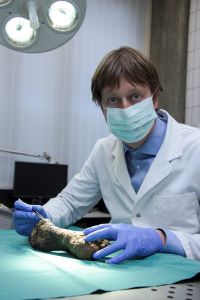30
AprARCE Members Only: The Mummy of Tutankhamun: Biomedical Investigations and Future Perspectives
Registration is required
Presented by: Frank Rühli; Founding Chair and Director of the Institute of Evolutionary Medicine and Dean of the Medical Faculty, University of Zurich, Switzerland
- 2:00 PM ET/ 9:00 PM EET
- Zoom
- + Add to Calendar
Lecture Information:
Tutankhamun (c. 1330 BCE) is one of the most famous personalities of ancient Egypt. His mummy has been investigated multiple times since its unwrapping in 1925 CE. The aim of this talk is to highlight the status of preservation and the history of biomedical investigations of all humans remains from KV 62, particularly of the mummified body of Tutankhamun. A particular focus will be laid on the results of the computed tomography investigation (lead by Dr. Z. Hawass, SCA) of the mummy. The main scenarios of his early death but also his general health status will be discussed. Also, still unanswered research questions shall be addressed- all in light of the generally important scientific and societal impact of biomedical research on ancient Egyptian mummies.
Speaker Bio:
Frank Rühli is the Founding Chair (Full Professor) and Director of the Institute of Evolutionary Medicine, as well as Dean of the Medical Faculty, University of Zurich, Switzerland. He has/ multiple visiting Professorships (a.o. NTU Singapore, The University of Adelaide). Since c.25 years he heads the Swiss Mummy Project and has examined hundreds of mummies globally. His active work experience in Egypt includes sites in Saqqara, Valley of the Kings, Sheikh Abd el-Qurna, el-Assasif/ Khokha or the at the Egyptian Museum Cairo. His main research interests are: Paleoradiology (x-ray, CT, MRI, Terahertz), ethical aspects of mummy studies, histological analyses, ancient DNA studies, anthropometric research, the study of embalming techniques, and experimental mummification. He has given lectures and workshops in Egypt in Cairo, Luxor, Fayum, and Bahariya. His mummy-related work has been funded a.o. by the Swiss National Science Foundation, the German Science Foundation, and the Swiss Federal Office of Culture.
